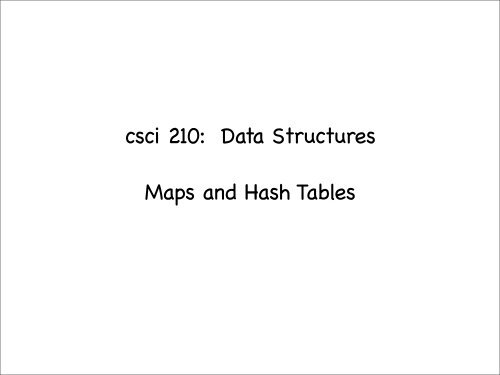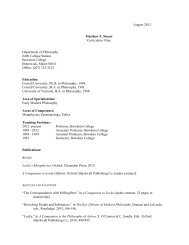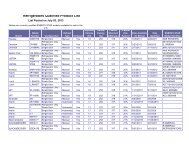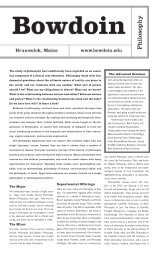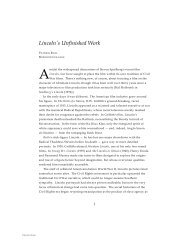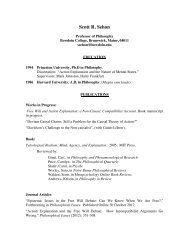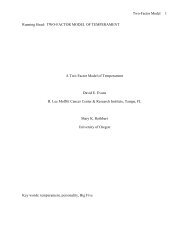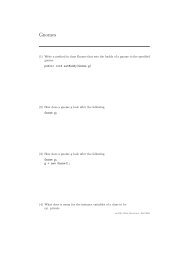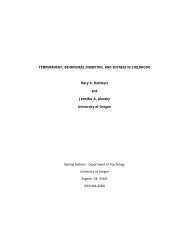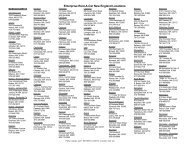csci 210: Data Structures Maps and Hash Tables
csci 210: Data Structures Maps and Hash Tables
csci 210: Data Structures Maps and Hash Tables
You also want an ePaper? Increase the reach of your titles
YUMPU automatically turns print PDFs into web optimized ePapers that Google loves.
<strong>csci</strong> <strong>210</strong>: <strong>Data</strong> <strong>Structures</strong><br />
<strong>Maps</strong> <strong>and</strong> <strong>Hash</strong> <strong>Tables</strong>
• Topics<br />
• the Map ADT<br />
• implementation of Map: hash tables<br />
• <strong>Hash</strong>ing<br />
• READING:<br />
• LC textbook chapter 14 <strong>and</strong> 15<br />
Summary
• A Map is an abstract data structure (ADT)<br />
• it stores key-value (k,v) pairs<br />
• there cannot be duplicate keys<br />
Map ADT<br />
• <strong>Maps</strong> are useful in situations where a key can be viewed as a unique identifier for the object<br />
• the key is used to decide where to store the object in the structure. In other words, the key<br />
associated with an object can be viewed as the address for the object<br />
• maps are sometimes called associative arrays<br />
• Note: <strong>Maps</strong> provide an alternative approach to searching<br />
Map ADT<br />
• size()<br />
• isEmpty()<br />
• get(k):<br />
this can be viewed as searching for key k<br />
• if M contains an entry with key k, return it; else return null<br />
• put(k,v):<br />
this can be viewed as inserting key k<br />
• if M does not have an entry with key k, add entry (k,v) <strong>and</strong> return null<br />
• else replace existing value of entry with v <strong>and</strong> return the old value<br />
• remove(k):<br />
• remove entry (k,*) from M<br />
this can be viewed as deleting key k
Map example<br />
(k,v) key=integer, value=letter<br />
• put(5,A)<br />
• put(7,B)<br />
• put(2,C)<br />
• put(8,D)<br />
• put(2,E)<br />
• get(7)<br />
• get(4)<br />
• get(2)<br />
• remove(5)<br />
• remove(2)<br />
• get(2)<br />
M={}<br />
M={(5,A)}<br />
M={(5,A), (7,B)}<br />
M={(5,A), (7,B), (2,C)}<br />
M={(5,A), (7,B), (2,C), (8,D)}<br />
M={(5,A), (7,B), (2,E), (8,D)}<br />
return B<br />
return null<br />
return E<br />
M={(7,B), (2,E), (8,D)}<br />
M={(7,B), (8,D)}<br />
return null
Example<br />
• Let’s say you want to implement a language dictionary. That is, you want to store words <strong>and</strong> their<br />
definition. You want to insert words to the dictionary, <strong>and</strong> retrieve the definition given a word.<br />
• Options:<br />
• vector<br />
• linked list<br />
• binary search tree<br />
• map<br />
• The map will store (word, definition of word) pairs.<br />
• key = word<br />
• note: words are unique<br />
• value = definition of word<br />
• get(word)<br />
• returns the definition if the word is in dictionary<br />
• returns null if the word is not in dictionary
• check out the interface<br />
• additional h<strong>and</strong>y methods<br />
• putAll<br />
• entrySet<br />
• containsValue<br />
• containsKey<br />
• Implementation?<br />
Java.util.Map
Class-work<br />
• Write a program that reads from the user the name of a text file, counts the word frequencies of all<br />
words in the file, <strong>and</strong> outputs a list of words <strong>and</strong> their frequency.<br />
• e.g. text file: article, poem, science, etc<br />
• Questions:<br />
• Think in terms of a Map data structure that associates keys to values.<br />
• What will be your pairs?<br />
• Sketch the main loop of your program.
• Arrays (Vector, ArrayList)<br />
• Linked-list<br />
• Binary search trees<br />
• <strong>Hash</strong> tables<br />
Map Implementations
A LinkedList implementation of <strong>Maps</strong><br />
• store the (k,v) pairs in a doubly linked list<br />
• get(k)<br />
• hop through the list until find the element with key k<br />
• put(k,v)<br />
• Node x = get(k)<br />
• if (x != null)<br />
• replace the value in x with v<br />
• else create a new node(k,v) <strong>and</strong> add it at the front<br />
• remove(k)<br />
• Node x = get(k)<br />
• if (x == null) return null<br />
• else remove node x from the list<br />
• Note: why doubly-linked? need to delete at an arbitrary position<br />
• Analysis: O(n) on a map with n elements
• Linked-list:<br />
Map Implementations<br />
• get/search, put/insert, remove/delete: O(n)<br />
• Binary search trees
<strong>Hash</strong>ing<br />
• A completely different approach to searching from the comparison-based methods (binary search,<br />
binary search trees)<br />
• rather than navigating through a dictionary data structure comparing the search key with the<br />
elements, hashing tries to reference an element in a table directly based on its key<br />
• hashing transforms a key into a table address
• If the keys were integers in the range 0 to 99<br />
• The simplest idea:<br />
• store keys in an array H[0..99]<br />
• H initially empty<br />
direct addressing:<br />
store key k at index k<br />
• put(k, value)<br />
• get(k)<br />
• store in H[k]<br />
• check if H[K] is empty<br />
x x x x<br />
<strong>Hash</strong>ing<br />
x<br />
...<br />
(0,v) x x (3,v) (4,v) ...<br />
issues:<br />
- keys need to be integers in a small range<br />
- space may be wasted is H not full
• <strong>Hash</strong>ing has 2 components<br />
• the hash table: an array A of size N<br />
<strong>Hash</strong>ing<br />
• each entry is thought of a bucket: a bucket array<br />
• a hash function: maps each key to a bucket<br />
• h is a function : {all possible keys} ----> {0, 1, 2, ..., N-1}<br />
• key k is stored in bucket h(k)<br />
0 1 2 3 4 5 6 8<br />
A ...<br />
• The size of the table N <strong>and</strong> the hash function are decided by the user<br />
bucket i stores all keys with h(k) =i
• keys: integers<br />
• chose N = 10<br />
• chose h(k) = k % 10<br />
Example<br />
• [ k % 10 is the remainder of k/10 ]<br />
0 1 2 3 4 5 6 7 8 9<br />
• add (2,*), (13,*), (15,*), (88,*), (2345,*), (100,*)<br />
• Collision: two keys that hash to the same value<br />
• e.g. 15, 2345 hash to slot 5<br />
• Note: if we were using direct addressing: N = 2^32. Unfeasible.
<strong>Hash</strong>ing<br />
• h : {universe of all possible keys} ----> {0,1,2,...,N-1}<br />
• The keys need not be integers<br />
• e.g. strings<br />
• define a hash function that maps strings to integers<br />
• The universe of all possible keys need not be small<br />
• e.g. strings<br />
• <strong>Hash</strong>ing is an example of space-time trade-off:<br />
• if there were no memory(space) limitation, simply store a huge table<br />
• O(1) search/insert/delete<br />
• if there were no time limitation, use a linked list <strong>and</strong> search sequentially<br />
• <strong>Hash</strong>ing: use a reasonable amount of memory <strong>and</strong> strike a balance space-time<br />
• adjust hash table size<br />
• Under some assumptions, hashing supports insert, delete <strong>and</strong> search in in O(1) time
• Notation:<br />
• U = universe of keys<br />
• N = hash table size<br />
• n = number of entries<br />
• note: n may be unknown beforeh<strong>and</strong><br />
• Goal of a hash function:<br />
<strong>Hash</strong>ing<br />
• the probability of any two keys hashing to the same slot is 1/N<br />
• Essentially this means that the hash function throws the keys uniformly at r<strong>and</strong>om into the<br />
table<br />
• If a hash function satisfies the universal hashing property, then the expected number of elements<br />
that hash to the same entry is n/N<br />
• if n < N : O(1) elements per entry<br />
• if n >= N: O(n/N) elements per entry<br />
called “universal hashing”
• Chosing h <strong>and</strong> N<br />
• Goal: distribute the keys<br />
• n is usually unknown<br />
<strong>Hash</strong>ing<br />
• If n > N, then the best one can hope for is that each bucket has O(n/N) elements<br />
• need a good hash function<br />
• search, insert, delete in O(n/N) time<br />
• If n less collisions <strong>and</strong> easier for the hash function to perform well<br />
• Best: if you can guess n beforeh<strong>and</strong>, chose N order of n<br />
• no space waste
• How to define a good hash function?<br />
<strong>Hash</strong> functions<br />
• An ideal has function approximates a r<strong>and</strong>om function: for each input element, every output<br />
should be in some sense equally likely<br />
• In general impossible to guarantee<br />
• Every hash function has a worst-case scenario where all elements map to the same entry<br />
• <strong>Hash</strong>ing = transforming a key to an integer<br />
• There exists a set of good heuristics
• Casting to an integer<br />
• if keys are short/int/char:<br />
• h(k) = (int) k;<br />
• if keys are float<br />
<strong>Hash</strong>ing strategies<br />
• convert the binary representation of k to an integer<br />
• in Java: h(k) = Float.floatToIntBits(k)<br />
• if keys are long long<br />
• h(k) = (int) k<br />
• lose half of the bits<br />
• Rule of thumb: want to use all bits of k when deciding the hash code of k<br />
• better chances of hash spreading the keys
• Summing components<br />
<strong>Hash</strong>ing strategies<br />
• let the binary representation of key k = <br />
• use all bits of k when computing the hash code of k<br />
• sum the high-order bits with the low-order bits<br />
• (int) + (int)<br />
• e.g. String s;<br />
• sum the integer representation of each character<br />
• (int)s[0] + (int)s[1] + (int) s[2] + ...
<strong>Hash</strong>ing strategies<br />
• summation is not a good choice for strings/character arrays<br />
• e.g. s1 = “temp10” <strong>and</strong> s2 = “temp01” collide<br />
• e.g. “stop”, “tops”, “pots”, “spot” collide<br />
• Polynomial hash codes<br />
• k = <br />
• take into consideration the position of x[i]<br />
• chose a number a >0 (a !=1)<br />
• h(k) = x0a k-1 + x1a k-2 + ...+xk-2a + xk-1<br />
• experimentally, a = 33, 37, 39, 41 are good choices when working with English words<br />
• produce less than 7 collision for 50,000 words!!!<br />
• Java hashCode for Strings uses one of these constants
• Need to take into account the size of the table<br />
• Modular hashing<br />
• h(k) = i mod N<br />
<strong>Hash</strong>ing strategies<br />
• If take N to be a prime number, this helps the spread out the hashed values<br />
• If N is not prime, there is a higher likelihood that patterns in the distribution of the input keys<br />
will be repeated in the distribution of the hash values<br />
• e.g. keys = {200, 205, <strong>210</strong>, 215, 220, ... 600}<br />
• N = 100<br />
• each hash code will collide with 3 others<br />
• N = 101<br />
• no collisions
• Combine modular <strong>and</strong> multiplicative:<br />
• h(k) = a k % N<br />
• chose a = r<strong>and</strong>om value in [0,1]<br />
<strong>Hash</strong>ing strategies<br />
• advantage: the value of N is not critical <strong>and</strong> need not be prime<br />
• empirically:<br />
• a popular choice is a = 0.618033 (the golden ratio)<br />
• chose N = power of 2
• If keys are not integers<br />
<strong>Hash</strong>ing strategies<br />
• transform the key piece by piece into an integer<br />
• need to deal with large values<br />
• e.g. key = string<br />
• h(k) = (s0a k-1 + s1a k-2 + ...+sk-2a + sk-1) %N<br />
• for e.g. a = 33<br />
• Horner’s method: h(k) = ((((s0a + s1)* a + s2)*a + s3)*a + ....)*a + sk-1<br />
int hash (char[] v, int N) {<br />
int h = 0, a = 33;<br />
for (int i=0; i< v.length; i++)<br />
h = (a *h + v[i])<br />
return h % N;<br />
• the } sum may produce a number than we can<br />
represent as an integer<br />
• take %N after every multiplication<br />
int hash (char[] v, int N) {<br />
int h = 0, a = 33;<br />
}<br />
for (int i=0; i< v.length; i++)<br />
h = (a *h + v[i]) %N<br />
return h;
• Universal hashing<br />
• chose N prime<br />
• chose p a prime number larger than N<br />
• chose a, b at r<strong>and</strong>om from {0,1,...p-1}<br />
• h(k) = ((a k + b) mod p) mod N<br />
<strong>Hash</strong>ing strategies<br />
• gets very close to having two keys collide with probability 1/N<br />
• i.e. to throwing the keys into the hash table r<strong>and</strong>omly<br />
• Many other variations of these have been studied, particularly has functions that can be<br />
implemented with efficient machine instructions such as shifting
• <strong>Hash</strong>ing<br />
1. hash function<br />
convert keys into table addresses<br />
2. collision h<strong>and</strong>ling<br />
<strong>Hash</strong>ing<br />
• Collision: two keys that hash to the same value<br />
Decide how to h<strong>and</strong>le when two kets hash to the same address<br />
• Note: if n > N there must be collisions<br />
• Collision with chaining<br />
• bucket arrays<br />
• Collision with probing<br />
• linear probing<br />
• quadratic probing<br />
• double hashing
Collisions with chaining<br />
• Store all elements that hash to the same entry in a linked list (array/vector)<br />
• Can chose to store the lists in sorted order or not<br />
• Insert(k)<br />
• insert k in the linked list of h(k)<br />
• Search(k)<br />
0 1 2 3 4 5 6 8<br />
A ...<br />
• search in the linked list of h(k)<br />
bucket i stores all keys with h(k) =i<br />
under universal hashing:<br />
each list has size O(n/N) with high probability<br />
insert, delete, search: O(n/N)
• Pros:<br />
Collisions with chaining<br />
• can h<strong>and</strong>le arbitrary number of collisions as there is no cap on the list size<br />
• don’t need to guess n ahead: if N is smaller than n, the elements will be chained<br />
• Cons: space waste<br />
A ...<br />
• use additional space in addition to the hash table<br />
• if N is too large compared to n, part of the hash table may be empty<br />
• Choosing N: space-time tradeoff<br />
0 1 2 3 4 5 6 8<br />
bucket i stores all keys with h(k) =i
Collisions with probing<br />
• Idea: do not use extra space, use only the hash table<br />
• Idea: when inserting key k, if slot h(k) is full, then try some other slots in the table until<br />
finding one that is empty<br />
• the set of slots tried for key k is called the probing sequence of k<br />
• Linear probing:<br />
• if slot h(k) is full, try next, try next, ...<br />
• probing sequence: h(k), h(k) + 1, h(k) + 2, ...<br />
• insert(k)<br />
• search(k)<br />
• delete(k)<br />
• Example: N = 10, h(k) = k % 10, collisions with linear probing<br />
• insert 1, 7, 4, 13, 23, 25, 25
Linear probing<br />
• Notation: alpha = n/N (load factor of the hash table)<br />
• In general performance of probing degrades inversely proportional with the load of the hash<br />
• for a sparse table (small alpha) we expect most searches to find an empty position within a few<br />
probes<br />
• for a nearly full table (alpha close to 1) a search could require a large number of probess<br />
• Proposition:<br />
Under certain r<strong>and</strong>omness assumption it can be shown that the average number of probes<br />
examined when searching for key k in a hash table with linear probing is 1/2 (1 + 1/(1 - alpha))<br />
• [No proof]<br />
• alpha = 0: 1 probe<br />
• alpha = 1/2: 1.5 probes (half-full)<br />
• alpha= 2/3: 2 probes (2/3 full)<br />
• alpha = 9/10: 5.5 probes<br />
• Collisions with probing: cannot insert more than N items in the table<br />
• need to guess n ahead<br />
• if at any point n is > N, need to re-allocate a new hash table, <strong>and</strong> re-hash everything. Expensive!
• Pros:<br />
• Con:<br />
• space efficiency<br />
• need to guess n correctly <strong>and</strong> set N > n<br />
• if alpha gets large ==> high penalty<br />
Linear probing<br />
• the table is resized <strong>and</strong> <strong>and</strong> all objects re-inserted into the new table<br />
• Rule of thumb: good performance with probing if alpha stays less than 2/3.
Double hashing<br />
• Empirically linear hashing introduces a phenomenon called clustering:<br />
• insertion of one key can increase the time for other keys with other hash values<br />
• groups of keys clustered together in the table<br />
• Double hashing:<br />
• instead of examining every successive position, use a second hash function to get a fixed<br />
increment<br />
• probing sequence: h1(k), h1(k) + h2(k), h1(k) + 2h2(k), h1(k) + 3h2(k),...<br />
• Chose h2 so that it never evaluates to 0 for any key<br />
• would give an infinite loop on first collision<br />
• Rule of thumb:<br />
• chose h2(k) relatively prime to N<br />
• Performance:<br />
• double hashing <strong>and</strong> linear hashing have the same performance for sparse tables<br />
• empirically double hashing eliminates clustering<br />
• we can allow the table to become more full with double hashing than with linear hashing<br />
before performance degrades
Java.util.<strong>Hash</strong>table<br />
• This class implements a hash table, which maps keys to values. Any non-null object can be used as<br />
a key or as a value.<br />
• java.lang.Object<br />
• java.util.Dictionary<br />
• java.util.<strong>Hash</strong>table<br />
• implements Map<br />
• [check out Java docs]<br />
• implements a Map with linear probing; uses .75 as maximal load factor, <strong>and</strong> rehashes every time<br />
the table gets fuller<br />
• Example<br />
//create a hashtable of pairs<br />
<strong>Hash</strong>table numbers = new <strong>Hash</strong>table();<br />
numbers.put("one", new Integer(1));<br />
numbers.put("two", new Integer(2));<br />
numbers.put("three", new Integer(3));<br />
//retrieve a string<br />
Integer n = (Integer)numbers.get("two");<br />
if (n != null) {<br />
System.out.println("two = " + n);<br />
}
<strong>Hash</strong> functions in Java<br />
• The generic Object class comes with a default hashCode() method that maps an Object to an integer<br />
• int hashCode()<br />
• Inherited by every Object<br />
• The default hashCode() returns the address of the Object’s location in memory<br />
• too generic<br />
• poor choice for most situations<br />
• Typically you want to override it<br />
• e.g. class String<br />
• overrides Strng.hashCode() with a hash function that works well on Strings
• Best hashing method depends on application<br />
Perspective<br />
• Probing is the method of choice if n can be guessed<br />
• Linear probing is fastest if table is sparse<br />
• Double hashing makes most efficient use of memory as it allows the table to become more full,<br />
but requires extra time to to compute a second hash function<br />
• rule of thumb: load factor < .66<br />
• Chaining is easiest to implement <strong>and</strong> does not need guessing n<br />
• rule of thumb: load factor < .9 for O(1) performance, but not vital<br />
• <strong>Hash</strong>ing can provide better performance than binary search trees if the keys are sufficiently r<strong>and</strong>om<br />
so that a good hash function can be developed<br />
• when hashing works, better use hashing than BST<br />
• However<br />
• <strong>Hash</strong>ing does not guarantee worst-case performance<br />
• Binary search trees support a wider range of operations
Exercises<br />
• What is the worst-case running time for inserting n key-value pairs into an initially empty map that<br />
is implemented with a list?<br />
• Describe how to use a map to implement the basic ops in a dictionary ADT, assuming that the user<br />
does not attempt to insert entries with the same key<br />
• Describe how an ordered list implemented as a doubly linked list could be used to implement the<br />
map ADT.<br />
• Draw the 11-entry hash that results from using the hash function h(i) = (2i+5) mod 11 to hash keys<br />
12, 44, 13, 88, 23, 94, 11, 39, 20, 16, 5.<br />
• (a) Assume collisions are h<strong>and</strong>led by chaining.<br />
• (b) Assume collisions are h<strong>and</strong>led by linear probing.<br />
• (c) Assume collisions are h<strong>and</strong>led with double hashing, with the secondary hash function h’(k)<br />
= 7 - (k mod 7).<br />
• Show the result of rehashing this table in a table of size 19, using teh new hasah function h(k) = 2k<br />
mod 19.<br />
• Think of a reason that you would not use a hash table to implement a dictionary.


